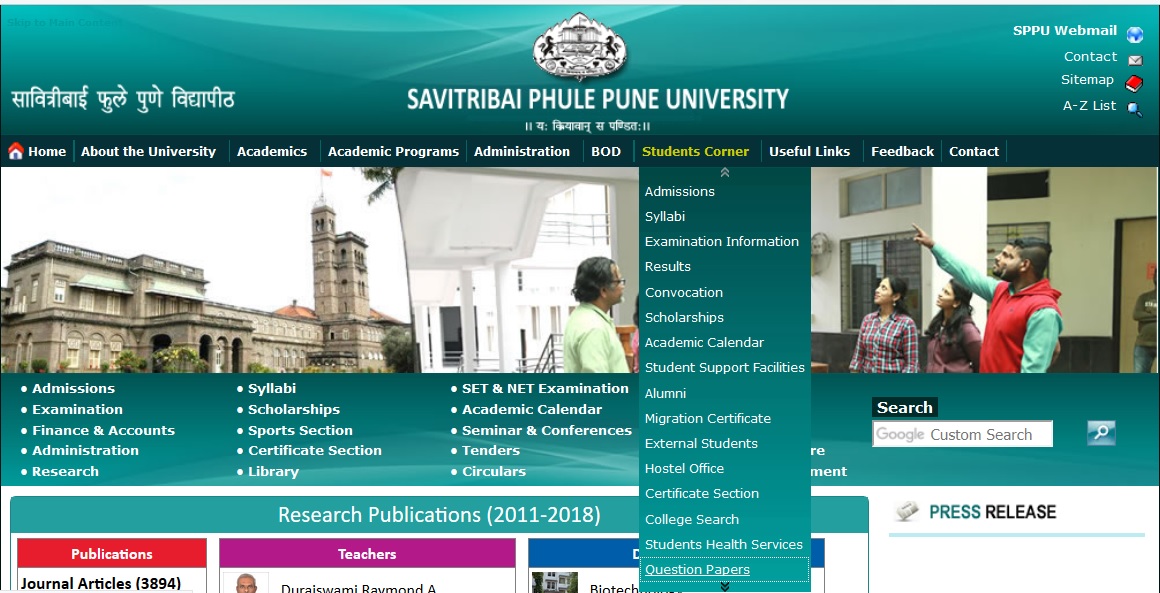Polymer Processing Operations-II B.E Question Paper : unipune.ac.in
Name of the University : Savitribai Phule Pune University
Department : Polymer Engineering
Degree : B.E
Subject Code/Name : Polymer Processing Operations – II
Sem : II
Website : unipune.ac.in
Document Type : Question Paper
Download Model/Sample Question Paper : https://www.pdfquestion.in/uploads/unipune.ac.in/6998-b.e..PDF
B.E. (Polymer Engg.) Sample Paper
Polymer Processing Operations – II :
(409369) (2003 Course) (Sem. – II)
Time : 3 Hours
Max. Marks : 100
Related : Savitribai Phule Pune University Industrial & Commercial Law B.E Question Paper : www.pdfquestion.in/6997.html
Instructions to the candidates:
1) Attempt Q.No. 1 or 2, Q. No. 3 or 4 and Q. No. 5 or 6 from Section – I.
Attempt Q. No. 7 or 8, Q. No. 9 or 10 and Q. No. 11 or 12 from Section – II.
2) Figures to the right indicate full marks.
3) Use of pocket calculator, log paper, log-log graph paper is allowed.
4) Answers to the two sections should be written in separate answer books.
5) Assume suitable design data, if required.

SECTION – I :
Q1) a) Explain in short the features of ‘Rock and Roll type rotational moulding machines’. [4]
b) Explain with neat sketch ‘Moulded in inserts’ with reference to rotational moulding. [4]
c) Explain in short effect of particle size and particle shape on processing of products by rotational moulding. [4]
d) Discuss the effect of following processing parameters on rotational moulding of liquid polymers. [4]
(i) Rotation speed.
(ii) Shot size.
e) Give any two advantages of rotational moulding of liquid polymers. [2]
Q2) a) Explain solid, hollow and kiss off or tack off type stiffening ribs used in rotational moulding. With neat sketch suggest recommended proportions for any one type. [5]
b) Give merits, features and cycle time chart for Independent arm type rotational moulding machine. [5]
c) Draw a typical internal mould air temperature profile during rotational moulding and show clearly the point at which plastic sticks to mould and the point at which plastic starts to pull away from mould wall. [5]
d) How pressure can be used as blowing agent in rotational moulding? [3]
Q3) a) Write in short about types of bearing used in calendering and their effect on product quality. [4]
b) Explain how matt surface finish is imparted to calendered sheet. [4]
c) With neat sketches, show clearly movable and fixed roll positions in z- type and three roll super imposed calender. [4]
d) With neat sketch, explain the use of hydraulic pull backs in case of calendering. [4]
Q4) a) Explain at least two faults or processing difficulties in case of calendering and give remedies. [4]
b) Explain different factors which determine the sheet path. [6]
c) A calender roll diameter is 0.4 meter and produces 3 mm thick plastic sheet. The sheet velocity is 0.1 m/sec. Find maximum pressure, Pmax, for a nip gap of 2.5 mm. Find also the point of maximum pressure. Take polymer viscosity as 1.5 × 103 Nsec/m2. [6]
Q5) Write short notes on (Any four) : [16]
a) Rainbow effect.
b) Polymer casting.
c) Texturising.
d) Embossing.
e) Slush moulding.
Q6) a) List advantages of flexographic printing. [4]
b) Describe the equipment and process of hot stamping. [6] c) Write in short about surface treatment prior to printing or painting on plastics. [6]
Polymer Syllabus :
Objective :
To impart the knowledge of compounding and mixing processes for the polymers and to study various mixing devices from the point of view of optimization of mixing time and power consumption.
Unit I: Polymer Mixing and Blending (8 hrs)
Introduction, basic concepts, mechanism of mixing and dispersion, mixing of solid-solid, liquidliquid and liquids-solids, dispersive mixing, distributive mixing and laminar mixing, mixing entropic measures and its applications, mixing indices, scale of segregation and intensity of segregation, kinetics of mixing, rheology of filled polymers, overview of polymer mixing and blending machinery.
Unit II: Compounding (8 hrs)
Introduction, types and characteristics of compounds – polymer blends, polymer formulations, filled polymers and polymer composites, compounding practice, mixing types, solid additives, morphology of filler additives, filler reinforcement, compatibilizers – mechanism and theory, filler surface modification and interfacial agents, dispersion of polymer nanoparticles in polymer melt.
Unit III: Polymer Compounds (8 hrs)
Polymer compound ingredients, fillers and reinforcements viz. carbon black, ZnO, calcium carbonate, titanium oxide, nano clay, glass fibers, organic fillers, nanofillers, processing aids, flame retardants etc., studies of polymer compound properties, multi-component compounds, compounding of polyolefins, polystyrene and styrene copolymers, engineering polymers, wood floor and natural fiber filled plastics, compounding lines, post compounding operations.